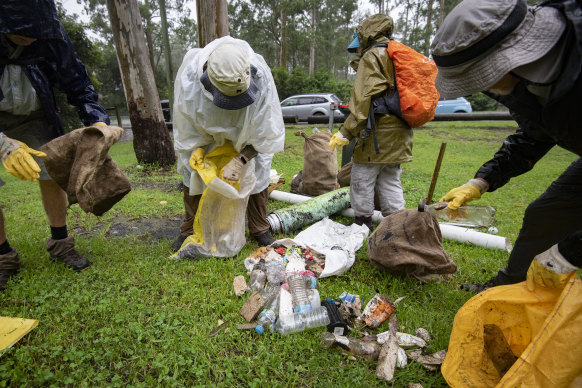This was published 8 months ago
The common food packaging ingredient linked to autism
A groundbreaking Australian study has linked plastic chemicals that are commonplace in food packaging and widespread in the environment to increased chances of a child developing autism.
The peer-reviewed paper comes months before a final round of global talks to curb plastic pollution.
The study, published in Nature Communication, found boys exposed to bisphenol A (BPA) chemicals in the womb were 3½ times more likely to have autism symptoms by age two and six times more likely to be diagnosed by age 11.

Clean Up Australia Day volunteers collecting plastic litter.Credit: Wolter Peeters
These chemicals are not found in all plastics, but they are widely used in plastic food packaging and the lining of metal food cans. They are usually eaten in trace amounts, but can also be inhaled or absorbed through the skin.
Study co-author Professor Anne-Louise Ponsonby said autism did not have a single cause, but arose from both genetic and environmental factors. She said this research, involving 25 studies with consistent findings, was one piece of the puzzle for boys in particular.
“It appears that in some autism cases, the plastics are a contributory factor,” Ponsonby said. “That doesn’t mean that the sole cause of autism in all cases is plastics. There will be some children who are very genetically predisposed towards autism, and there will be other ones for which other environmental influences are important.”
The research from The Florey, the largest brain research institute in the southern hemisphere, was funded by Minderoo Foundation and first reported in The Australian on Thursday.

Kayaker Vanesa Moyano picking up rubbish during a Sydney by Kayak tour of Sydney Harbour.Credit: Janie Barrett
The human studies, looking at 1770 pairs of mothers and children over 10 years in Australia and the United States, reviewed the BPA levels detected in pregnant mothers and found this was associated with gene switching to suppress the aromatase enzyme and subsequently with higher rates of autism diagnoses.
The researchers also conducted experiments with mice, and found that when the genes for the aromatase enzyme were deleted, it induced repetitive behaviours in the animals. In humans, repetitive behaviours is one of the flags for an autism diagnosis.
Ponsonby said the aromatase enzyme was important in brain development, especially for boys as it converts androgen hormones into brain oestrogen. The research also pointed to a compound found in royal jelly as a potential antidote, but Ponsonby said more research was needed.
Dr Ian Musgrave, a senior lecturer in medicine at the University of Adelaide, said “autism is hugely more prevalent in boys”, and while it was possible this was partly because of under-diagnosis in girls, there were biological factors as well.
Musgrave added that previous research had suggested air pollution from nitrogen dioxide, a common greenhouse gas, also contributed to autism.
Musgrave said the Florey research was an excellent study, but it was unclear how transferable the findings about animal behaviour was to real-world autism in humans, which could range from high-functioning to non-verbal. He also said the level of BPA in the environment in Australia was much lower than in this research.
Professor Ian Rae, an expert on chemicals in the environment at the University of Melbourne, said BPA chemicals could leach into the environment or food. The first way was in the manufacturing process, if there were leftover chains that were not incorporated into the polymer, and the second way was if the polymer broke down, which could occur by heating it.
Rae said there was not as much BPA contamination in the wider environment as for PFAS chemicals, which are in the soil and drinking water because of being used in products such as firefighting foams.

A person with autism on the ABC show You Can’t Ask That.
“If you’ve got these things in the landfill and the landfill is leaking, as some of them do, it can leach into the environment, but the main concentration here has been about getting into food contamination,” Rae said.
The final round of United Nations talks to agree an international plastic treaty will be held in South Korea in late November, with Australia part of a coalition of countries pushing to reduce new plastic production.
The Minderoo Foundation, founded by billionaires Dr Andrew Forrest and his former wife Nicola Forrest, funded the research as part of its commitment to building evidence on the harmful effects of plastic pollution.
Minderoo Foundation director Jay Weatherill said: “From the water we drink to the products we use, plastics are an inescapable part of modern living. These new findings strengthen the call for a comprehensive and ambitious global plastics treaty to protect human health from the impact of plastic chemicals.”
Food Safety Australia & New Zealand website states the evidence suggests there is no safety concern with BPA chemicals at the levels people are exposed to.
Get to the heart of what’s happening with climate change and the environment. Sign up for our fortnightly Environment newsletter.